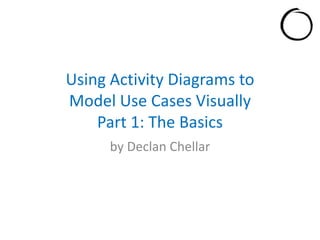
Activity diagram tutorial
- 1. UsingActivityDiagrams toModel Use Cases VisuallyPart 1: TheBasics by Declan Chellar
- 3. START POINT
- 4. TheStart Point representstheEVENT that triggersthe use case.
- 5. LabeltheStart Point to makethe INTENT and TRIGGER of the use case explicit.
- 6. Actor elects to AddCustomer
- 7. Actor elects to AddCustomer END POINT
- 8. Actor elects to AddCustomer LabeltheEnd Point to EXPLICITLY confirm that theintent of the use case has beenachieved.
- 9. Actor elects to AddCustomer Customeradded
- 10. Actor elects to AddCustomer This makesitclear to thereader that the use case is complete and that nothingfurther is needed in order to fulfiltheintent. Customeradded
- 11. Actor elects to AddCustomer NOT a goodlabelforanEnd Point End of process
- 13. … you need to model STEPS.
- 16. Transitions use arrowheads to show thedirection of processflow.
- 17. I like to put a note againstanystep that achievesthegoal of the use case. Goal X achieved
- 18. Goal X achieved … becauseitmightnotbethelaststep.
- 19. Themostcommonroutefromthestartpoint to theendpoint has manynames.
- 21. Combine anywordontheleftwithanyphraseontheright. PRIMARY… …PATH BASIC… …FLOW TYPICAL… …COURSE OF EVENTS …SCENARIO
- 22. Often in a use case theSystem has to make a decisionbasedonbusiness rules...
- 23. The actual decisiontakes place within a STEP
- 24. System determines whether X or Y The actual decisiontakes place within a STEP
- 25. System determines whether X or Y A DECISION POINT is then used to helpthereadernavigatethediagram.
- 26. DECISION POINT
- 27. DecisionPointscontaintextwhich describes thenature of thedecision to bemade.
- 28. So wasit X or Y?
- 30. Transitionscomingout of DecisionPointsmust have a GUARD. [Condition 2] [Condition 1]
- 31. [IT WAS “Y”] [IT WAS “X”] A Guardneeds to explicitly describe a conditionwhichmustbe true in order to proceeddown that path.
- 32. IftheflowrejoinsthePrimaryPath, it is known as anAlternatePath. [Condition 2] [Condition 1]
- 33. [Condition 2] [Condition 1] WithAlternatePaths, thegoal of the Use Case is stillachieved.
- 34. There are othernamesforAlternatePaths. [Condition 2] [Condition 1]
- 35. Combine anywordontheleftwithanyphraseontheright. ALTERNATE… …PATH ALTERNATIVE… …FLOW SECONDARY… …COURSE OF EVENTS …SCENARIO [Condition 2] [Condition 1]
- 36. [Condition 2] [Condition 1] You can show howpathsrejoinbyusing a MERGE POINT.
- 37. [Condition 2] [Condition 1] You can show howpathsrejoinbyusing a MERGE POINT.
- 38. I don’tlikeMergePointsbecausetheytake up spacewithoutaddingclarity. [Condition 2] [Condition 1]
- 39. I prefer to modelmergingpathslikethis. [Condition 2] [Condition 1]
- 40. MergePoints can sometimesbeparticularlysuperfluous. [Condition 2] [Condition 1]
- 41. [Condition 2] [Condition 1] I thinkit is neater to show themergethisway.
- 42. Iftheflowdoes NOT rejointhePrimaryPath, it is known as anExceptionPath. [Condition 2] [Condition3] [Condition 1]
- 43. WithExceptionPaths, thegoal of the Use Case is NOT achieved. [Condition 2] [Condition3] [Condition 1] Goal X achieved
- 44. WithExceptionPaths, thegoal of the Use Case is NOT achieved. [Condition 2] [Condition3] [Condition 1] Uh, oh! Goal X achieved
- 45. I like to use colour to highlightthedifferentpaths. [Condition 2] [Condition3] [Condition 1]
- 46. [Condition 2] [Condition3] [Condition 1]
- 47. [Condition 2] [Condition3] [Condition 1]
- 48. This makesiteasy to identify test scenarios at a glance. [Condition3] [Condition 2] [Condition 1]
- 49. I alsolike to labeltheGuards in order to easilyidentifythepaths. A1: [Condition 2] E1: [Condition 3] P: [Condition 1]
- 50. And I like to labeltheStepsforeasybackwardreferencefrom Business Rules and a Logical Data Model. P1: A1: [Condition 2] E1: [Condition 3] P: [Condition 1] P2: A1.1: E1.1:
- 51. PrimaryPath: P1, P2. P1: A1: [Condition 2] E1: [Condition 3] P: [Condition 1] P2: A1.1: E1.1:
- 52. PrimaryPath: P1, P2. AlternatePath 1: P1, A1.1, P2. P1: A1: [Condition 2] E1: [Condition 3] P: [Condition 1] P2: A1.1: E1.1:
- 53. PrimaryPath: P1, P2. AlternatePath 1: P1, A1.1, P2. ExceptionPath 1: P1, E1.1. P1: A1: [Condition 2] E1: [Condition 3] P: [Condition 1] P2: A1.1: E1.1:
- 54. In some Use Cases, you willneed to modelparallelsteps [Condition 2] [Condition3] [Condition 1]
- 55. [Condition 2] [Condition3] [Condition 1] X A B In thisexample, steps A and B mustbothstartafterstep X finishes and mustbothfinishbeforethe Use Case ends.
- 56. [Condition 2] [Condition3] [Condition 1] X A B Butwe do notcareabouttheorder in which A and B happen.
- 57. A and B couldevenhappen at thesame time. [Condition 2] [Condition3] [Condition 1] X A B
- 58. In thisexample, B mustfollow A, butwe do notcarewhen C happens in relation to (A + B). [Condition 2] [Condition3] [Condition 1] A C B
- 59. In some Use Cases, you willneed to modelrepeatedsteps. [Condition 2] [Condition3] [Condition 1] A B
- 60. [Condition 2] [Condition3] [Condition 1] Foreach X: A In thisexample, you repeat (A + B) untilthere is no more X. B
- 61. [Condition 2] [Condition3] [Condition 1] Foreach X: A Forexample, you might do thiswhenaddingpassengers to a holidaybooking. B
- 63. START POINT DECISION POINT [Condition] END POINT GUARD STEP PARALLEL STEPS Foreach X: TRANSITION REPEATED STEPS
